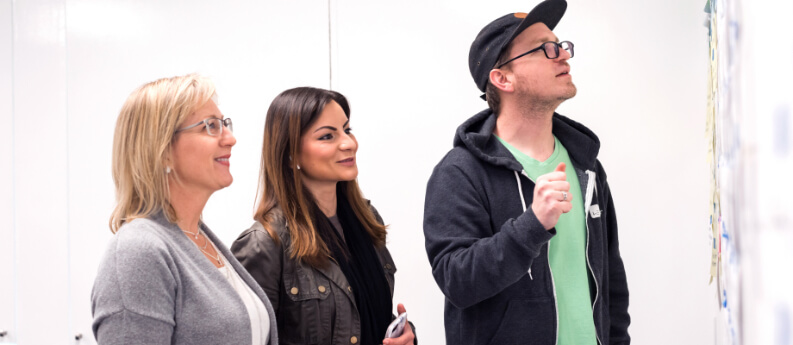The era of marketers hiring an agency and not getting an update until the work is complete or almost complete is coming to an end. If you are about to embark on a new agency relationship then you may be curious about how the agency team will effectively integrate with your in-house team. You may wonder how this new partnership will start strong, and how communication lines will operate throughout the engagement. There are two important milestones in building this relationship. The first is client onboarding, where teams first align and define the business objectives and guidelines for their relationship. The second is the retrospective, where teams pause to reflect, learn and endeavor to improve their work by celebrating their achievements and bringing any issues to the fore for knowledge-sharing, discussion and resolution.
Client onboarding: Nurturing the relationship from the beginning
At Clear Digital, client onboarding is a critical first step in the process. This sets the tone and lays the foundation for the collaborative agency-client relationship as we begin working together. It is at this point that the group establishes ownership, outlines expectations and setting the direction for the initial project.
When agencies execute poorly or skip this crucial step entirely, misunderstandings can become commonplace and the team carries additional risk through their project. Communication problems often emerge and problems can escalate to a level where the relationship itself can be threatened.

Open communication: Elements of an effective process
Once the first contract is signed, we will lead you through an onboarding process that contains several important elements:
- Clear Digital leadership is highly visible and invests extra attention by actively participating in each new client onboarding.
- A detailed agenda is delivered prior to the initial meeting that sets expectations and allows our combined team time to come prepared with important questions.
- Project owners and key project stakeholders from both the agency and client are introduced and understand their respective roles.
- Project scope is reviewed and the team emerges aligned, with understanding that scope creep is a threat to project success.
- High-level project schedule and key milestones are reviewed, and potential tradeoffs are understood.
- Communication needs are discussed and reviewed and collaboration tools and preferences are established.
- Summary notes of the discussion, agreements and next steps are promptly provided to all participants.
- Check-ins are planned to make sure that follow through on the commitments established in onboarding is supported throughout the campaign.
Emerging from client onboarding as a team
Your team should emerge feeling the faith and company investment placed in our agency are well placed and that all bases are covered. The Clear Digital team will make it obvious that immediate next steps are known, organized, and prioritized and that all bases are covered.
At this point, our teams should be one cohesive unit. The tone has been set and the team completely understands what it’s trying to achieve.
Project execution: Keeping the right things in mind
As the team executes their first project together, they build trust on the foundation first set in the onboarding process. Transparent team communication and visible collaboration are great indicators that this has carried forward.
Throughout the project, it is important that the team keep the onboarding experience and agreements in mind, making necessary course corrections along the way. The team should also be keeping in mind how they might carry forward what they’ve learned as the agency-client relationship continues to grow.
This final piece is formalized, documented and operationalized in the retrospective.

Retrospective: Not just at the end of the project
High-performing teams talk about improvements throughout the course of their work. In the fast-paced digital agency environment, however, it is important at project conclusion for the team to take the time to pause and reflect in a more formal way.
Some teams can initially struggle with understanding the value of a formal retrospective, particularly those that face a daunting workload or a history of ineffective meetings. To support a healthy retrospective culture, the team must have clear management support and continue to nurture a culture of openness. It is incumbent on leadership, too, to make sure the highlights emerging in the retrospective have management support on both the agency and client side of the relationship.
Taking stock of what was learned
The most efficient retrospectives include some prework across the team. At times, this means separate pre-discussions at agency and/or client side to gather and organize thoughts as well as emergent themes across the team before the full-team session is held.
The goal of the retrospective is to carry forward lessons learned — both big and small — across the team in a meaningful, actionable way. One common format is for the team to openly discuss what worked well, what didn’t work well, and what was learned during the project.
Specific questions the team might consider include the following:
- What made the project successful and helped achieve the business goals?
- What trends did the team see and how did they affect performance?
- What decisions made during the project might inform future work?
- How can the team maintain or improve the project deliverables going forward?
- What business opportunities remain unaddressed?
- How can the team work better together?
Carrying the culture of trust forward
Good retrospectives help teams capture better understanding and insights about themselves, their work and the business that can be carried forward no matter what happens in the organizational relationship beyond that point.
Key retrospective notes that are operationalized not only improve business results, but boost team morale as individual contributors see their feedback recognized and translated into action.

Final thoughts
Effective onboarding, project execution, and retrospectives are essential to building the kind of partnership where teams thrive, results are delivered, and long-term trust is established.
Onboarding done right sets the tone for the business relationship to be strong, creating a process for the team to execute effectively. By the end of a thoughtful retrospective, even though things are never perfect, the team emerges confident in the work it does and in the relationship they’ve created.






